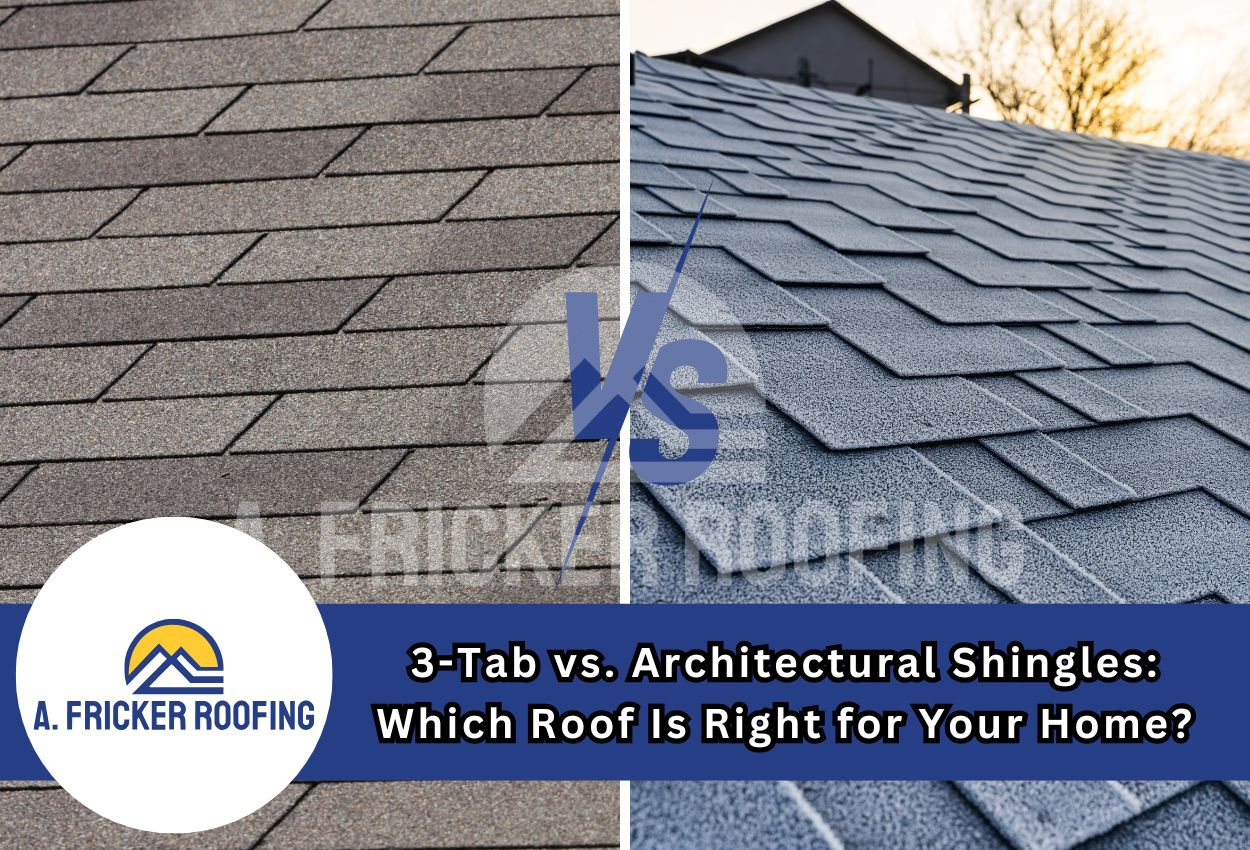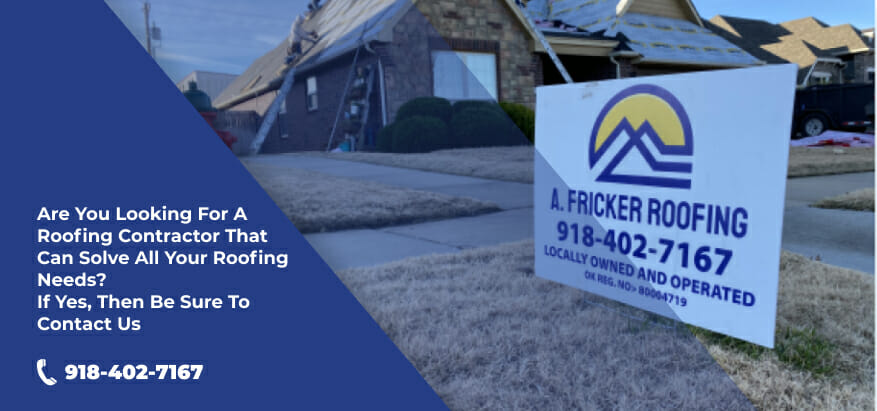When it’s time for roof replacement, shingles are the first material that will likely come to your mind when you’re thinking of what to replace your old roof with. After all, asphalt shingles still remain the most popular and prolific roofing material in Oklahoma.
But between the last time you replaced your roof and today, a lot has changed. 3-Tab shingles are not the only option you have now. With constant advancements, architectural shingles have made a splash in the market too.
While both serve the same fundamental purpose of protecting your home from the outside elements, their differences make a big impact on your investment.
We understand this can be overwhelming, but don’t worry, as we are here to make things easier. Today, we’ll compare 3-tab vs. architectural shingles in detail. After reading, you’ll have a clearer understanding of whether you should go for a new, durable architectural range or stick to a traditional classic roofing shingle.
What Are 3-Tab Shingles?

Almost all homeowners recognize 3-tab shingles as they’re so common due to being the most traditional and budget-friendly roofing option. Their name comes from the way they are manufactured — each shingle strip is cut into three equal tabs, giving them a uniform, flat appearance.
Pros of 3-Tab Shingles:
- Lower upfront cost: If you’re looking for an economical roofing solution, 3-tab shingles are the most affordable option, costing as little as $1.5 per square foot.
- Simplicity: They provide a clean, consistent look that can suit a variety of home styles.
- Lightweight: Because they’re thinner than architectural shingles, they put less strain on your roofing structure.
Cons of 3-Tab Shingles:
- Shorter lifespan: Typically, 3-tab shingles last between 15 and 25 years, significantly less than architectural shingles.
- Less durable: They are more prone to damage from wind, hail, and severe weather.
- Limited design options: Their flat design lacks the dimension and texture that many homeowners prefer today.
What Are Architectural Shingles?

3-Tab shingles were an effective choice but lacked the durability a shingle requires to withstand harsh conditions, especially in the Southwest. To counter this, shingle manufacturers came up with thicker architectural shingles.
Also known as dimensional or laminate shingles, these are a premium roofing material designed to provide better durability and appearance. Unlike 3-tab roof shingles, they feature multiple layers of asphalt, giving them a thicker, more textured appearance. Some of these shingles often come with the look of high-end roofing materials like wood or slate.
Pros of Architectural Shingles:
- Longer lifespan: Most architectural shingles last 25 to 30 years
- Better durability: They can withstand stronger winds (up to 130 mph) and harsh weather conditions much better than 3-tab shingles
- Enhanced curb appeal: Their layered, dimensional look adds depth and character to your roof, increasing your home’s overall value
- Better warranties: Because of their durability, manufacturers often offer longer and more comprehensive warranties on architectural shingles
Cons of Architectural Shingles:
- Higher cost: The upfront price of architectural shingles is higher than 3-tab shingles, but their longevity and durability make them a better long-term investment.
Key Differences: 3-Tab vs. Architectural Shingles
| Feature | 3-Tab Shingles | Architectural Shingles |
| Lifespan | 15 to 20 years | 25 to 35 years |
| Durability | Moderate | High |
| Wind Resistance | Up to 60 mph | Up to 130 mph |
| Aesthetic Appeal | Flat, uniform look | Dimensional, high-end look |
| Cost | 3-Tab shingles cost about $1.5 to $3 per square foot. (Lower upfront cost) | Architectural shingles cost around $4 to $7 per square foot. (Higher upfront cost, but better value over time) |
| Weight | Lighter | About 50% to 60% heavier (Multi-ply asphalt) |
| Warranty | Shorter coverage | Longer, more comprehensive coverage |
Lifespan
3-Tab Shingles:
These last around 15 to 20 years because they are made with a single layer of asphalt. Their thinner structure makes them more vulnerable to wear and tear and the shingle deteriorates faster, leading to a shorter lifespan compared to architectural shingles.
Architectural Shingles:
These last 25 to 35 years, sometimes even up to 40 years, with proper maintenance. As we covered earlier, they have multiple layers of asphalt, making them more resistant to damage and aging.
Also Read: How Long Do Asphalt Shingle Roofs Last?
Durability
3-Tab Shingles:
With moderate durability, these asphalt shingles handle everyday weather but are prone to curling, cracking, and losing granules over time. Severe weather, such as hail or strong winds, can cause more damage easily.
Architectural Shingles:
Due to their relatively thicker composition, dimensional shingles are highly durable. They can withstand the harsh weather of Oklahoma, such as heavy rains and storms, better than traditional options. Due to this, dimensional shingles are a much more reliable choice for long-term protection.
Wind Resistance
The past year brought with it some of the most severe weather conditions in Oklahoma. The state received over 150 tornadoes and several windstorms. To withstand this, you need a shingle with great wind resistance.
3-Tab Shingles:
These roofing shingles can resist winds up to 60 mph, but strong gusts can lift and tear them off, leading to frequent repairs or replacement.
Architectural Shingles:
With a wind resistance of up to 130 mph, these shingles hold up well in stormy conditions, making them a better deal if you own a home in Oklahoma.
Aesthetic Appeal
How your home looks is also important to many homeowners. This part is subjective and depends on what you want out of your shingles.
3-Tab Shingles:
These offer a flat, uniform look that may appear somewhat plain and outdated compared to modern roofing options.
Architectural Shingles:
Their dimensional, high-end appearance mimics more expensive materials like wood or slate. You also get more shingle color options here, easily allowing you to increase your home’s value.
Cost
3-Tab Shingles:
These are quite cost effective and a no-brainer if you are on a strict budget. You can get these at less than $3 per square foot, which not only makes them a great option for budget-conscious homeowners, but also for people with short-term housing plans.
Architectural Shingles:
Architectural shingles are known for costing more than 3-tab shingle replacement options, coming in at around $4 to $8 per square foot. While the initial investment is higher, the longer lifespan and lower maintenance needs make them a more cost-effective option in the long run.
To learn more about the cost of asphalt shingles, check out our blog post.
Weight and Composition
3-Tab Shingles:
Lighter in weight due to their single-layer construction, these shingles are easier to install but also more prone to damage.
Architectural Shingles:
Most architectural shingles are manufactured with SBS-modified asphalt. They are also heavier due to a multi-layer construction, which improves durability and insulation, but may require additional structural support in older homes.
Warranty
3-Tab Shingles:
This type of shingle typically comes with shorter warranties, ranging from 15 to 20 years, reflecting their expected lifespan and lower durability.
Architectural Shingles:
Top manufacturers such as GAF, CertainTeed, and TAMKO offer longer warranties with their architectural asphalt shingles due to their superior performance and resilience.
Get The Best For Your Roof With A. Fricker Roofing and Waterproofing
After this comparison, you’ll note that architectural shingles tend to be the better option over 3-tab shingles in most categories. While 3-tab shingles are better for those on a budget, architectural shingles are better in terms of long-term value.
As a roofing company with years of experience, we would advise you to get architectural or luxury shingles when replacing your roof. 3-Tab shingles are outdated, and most manufacturers do not offer their best warranties on these products
If you want the best roof replacement service, contact our experts today at (918) 402-7167.

